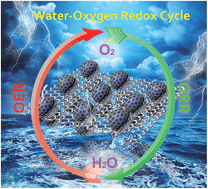Highly active Co–Mo–C/NRGO composite as an efficient oxygen electrode for water–oxygen redox cycle†
Abstract
The slow kinetics of the oxygen evolution reaction (OER) and the oxygen reduction reaction (ORR) have hindered energy conversion and storage greatly. Design of a new class of low-cost and highly efficient electrocatalysts for the water–oxygen redox cycle (WORC) system including OER and ORR is considered a huge challenge. Controlled synthesis of unique and stable precursors as a perfect platform to synthesize target products with diverse compositions are of vital importance. Herein, we synthesized a metal/metal carbide-based composite (denoted as Co–Mo–C/NRGO-1) by directly carbonizing Co-doped polyoxometalate/conductive polymer/graphene precursor (Co-PCG) as an efficient bi-functional electrocatalyst. The resulting Co–Mo–C/NRGO-1 composite exhibited superior electrocatalytic activity for OER with an ultra-low Tafel slope of 42 mV dec−1, a small overpotential of 330 mV vs. RHE at the current density of 10 mA cm−2 and long-term stability in alkaline medium. The ORR performance was also investigated with a positive onset potential (∼−95 mV vs. Ag/AgCl), remarkable stability over 30 000 s and good tolerance to methanol crossover. Most importantly, the OER performance of Co–Mo–C/NRGO-1 was the best among all the reported carbide-based materials and was comparable to the best OER electrodes.


 Please wait while we load your content...
Please wait while we load your content...